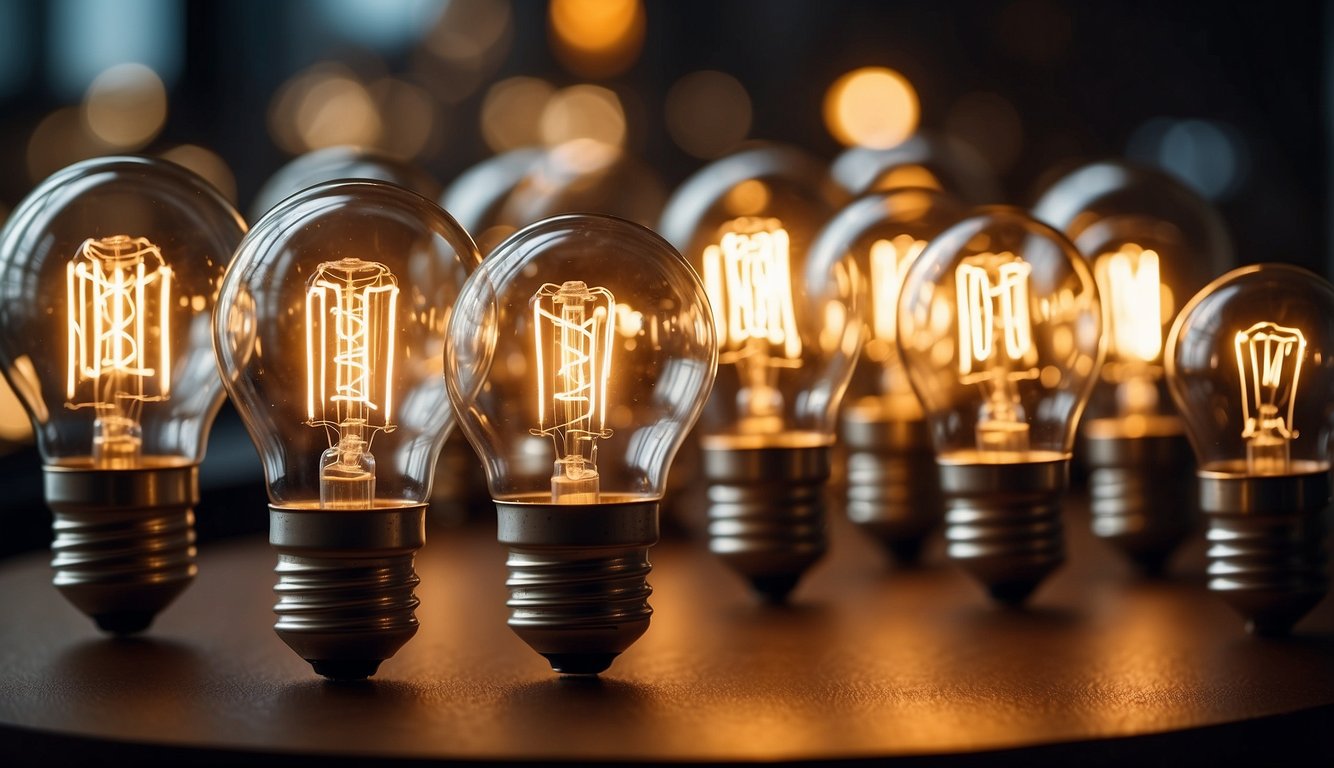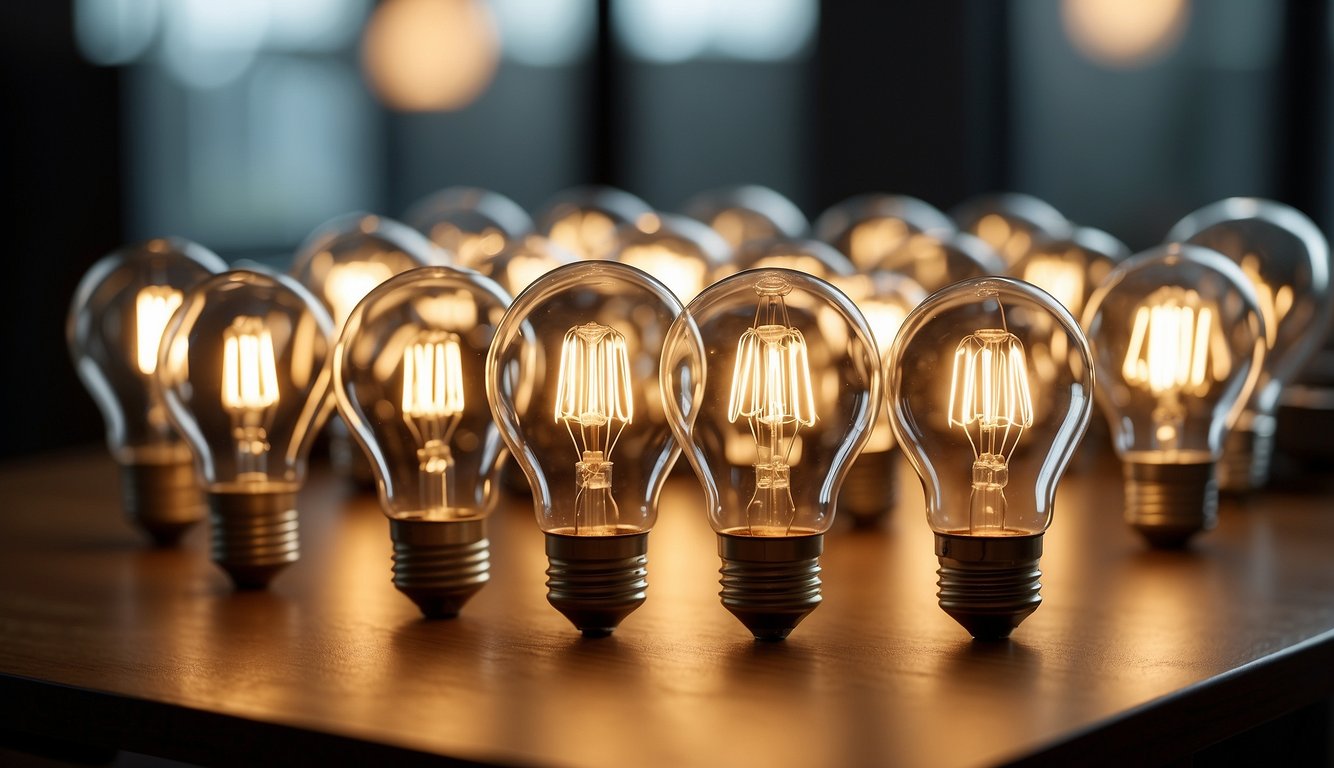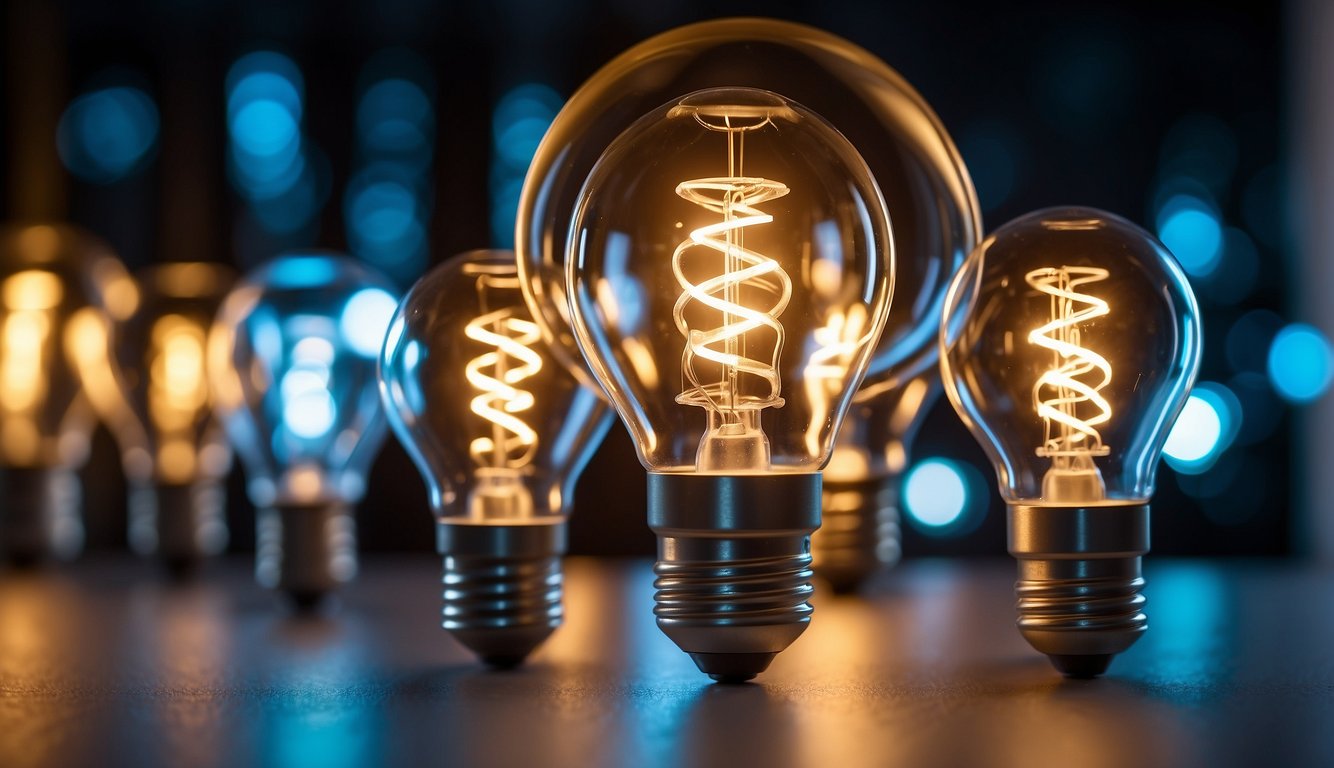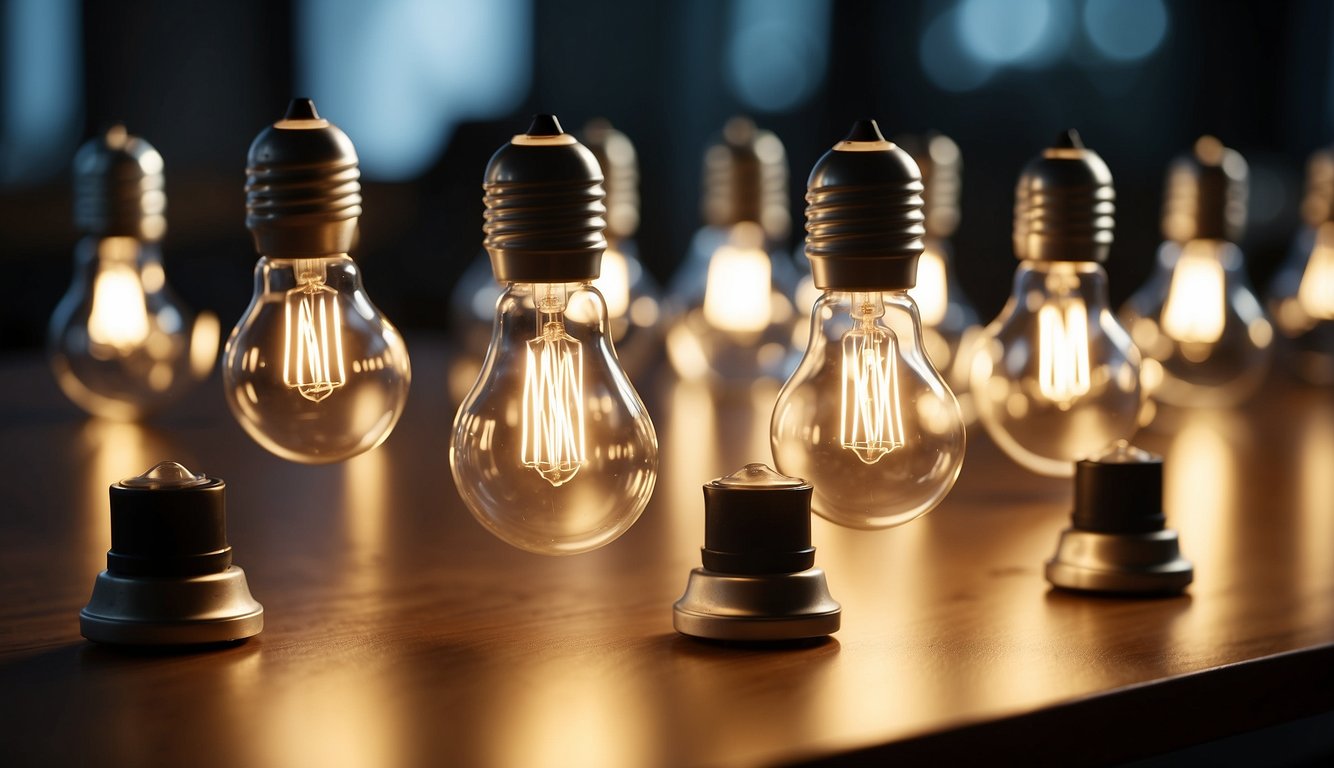Light bulb bases are the foundation of every lighting fixture in your home, acting as the crucial connecting point between the electrical power in your fixture and the light bulb itself. Different fixtures and lamps require varying bases not only to supply power but also to securely hold the bulb in place. From the iconic Edison screw to specialized pin bases, each has been designed with both functionality and compatibility in mind.

Understanding light bulb base sizes is essential when replacing a bulb in your chandelier or any other fixture. The size must match to ensure the bulb fits properly without risk of electrical issues or physical damage. With a range of sizes from the small E12 candelabra to the larger E26 medium base, it’s important to choose the correct base type for your specific lighting needs. These bases play a pivotal role in the safe operation and longevity of the light bulbs and fixtures they support.
Key Takeaways
- Light bulb bases connect bulbs to the power and fixture for proper function.
- Match base sizes and types correctly to ensure bulbs fit securely in fixtures.
- Selection of the right base impacts overall bulb performance and safety.
Basic Types of Light Bulb Bases
Understanding the different light bulb bases is essential for matching your bulbs to the right fixtures. From commonly used screw bases to pin bases and some less typical specialty bases, you’ll find a variety that suits various lighting needs.
Screw Bases
Screw bases, also known as Edison screw bases, come in sizes often denoted by an “E” followed by a number, which indicates the diameter in millimeters. The E26 base is your standard medium screw base, widely used in North America for household lighting. Meanwhile, the E12 base, known as the candelabra, is smaller in diameter and frequently seen in decorative fixtures. For larger, high-wattage fixtures, the E39 base, or the mogul screw base, is the size you’re likely to encounter. There’s also an E17 base, labeled as intermediate, which fills the gap between medium and candelabra sizes.
Pin Bases
Pin bases consist of two metal pins that connect the bulb to the fixture’s power. The GU10 base has a twist-lock mechanism, commonly used for halogen bulbs in track lighting or recessed fixtures. Another variant, GU24 base, features two pins that stick straight out and lock into the fixture with a quarter twist. For small, low-voltage fixtures like under-cabinet lighting or desk lamps, you might come across the G4 base, featuring two thin pins spaced 4mm apart.
Specialty Bases
Apart from the standard screw and pin bases, there are specialty bases designed for particular applications or specific fixtures. These can range from miniature bases found in some appliances or specialized equipment to what are known as midget bases, used in dashboard lights, electronics, or small indicators. The base types here are less standardized and can vary widely, so it’s important to check your fixture’s requirements before making a purchase.
Edison Screw Base Variants
When exploring the world of lighting technology, you will encounter various Edison Screw base variants, each designed for different applications. Thomas Edison, who first patented the Edison Screw base, paved the way for a vast array of bulbs fitting into numerous sockets for your home or office.
Edison Screw (ES)
The Edison Screw (ES), commonly known as E26, is the standard screw base widely utilized across North America. Measuring 26 millimeters in diameter, it’s the most prevalent medium-sized base for residential lighting. This versatile base ensures that your lighting solutions are easy to find and replace, allowing a seamless transition when a bulb flickers out.
Candelabra Edison Screw (CES)
For smaller fixtures and decorative lighting, you’ll most often use the Candelabra Edison Screw (CES), recognized also by its code, E12. With a diameter of just 12 millimeters, this base is perfect for creating an intimate ambiance with its petite design and commonly used in chandeliers or night lights.
Intermediate Edison Screw (IES)
Slightly larger than the candelabra base is the Intermediate Edison Screw (IES) or E17. With its 17-millimeter diameter, it fills the gap between the candelabra and standard Edison Screw bases. You’ll find these in appliances like microwaves and other lighting situations that require a smaller bulb than ES but bigger than CES.
Mogul and Miniature Bases
Finally, the Mogul Edison Screw, known as E39 or Goliath Edison Screw, features a substantial diameter of 39 millimeters and is used for high-wattage bulbs often found in industrial environments. Alternatively, miniature bases, which include the Mini-Candelabra, provide options for even tinier sockets, offering versatility in lighting design and bulb replacement.
Sizes and Dimensions
When choosing light bulbs, diameter and dimension standards are crucial to ensure the bulb fits your fixture. You’ll encounter measurements primarily in millimeters (mm), indicating the diameter of the bulb’s base, directly related to the socket size.
Measuring Diameter
To measure the diameter of a light bulb base, you’ll use millimeters to get the precise size. For screw bases, the number following “E” represents the diameter in millimeters. For example:
- E10 – 10mm diameter, often referred to as Miniature Screw.
- E12 – 12mm diameter, commonly known as Candelabra.
- E26 – 26mm diameter, the standard size for most household bulbs in the US.
For pin bases, measurement between the two pins is key. Examples include:
- G4 – The distance between pins is approximately 4mm.
- GU10 – A twist-and-lock base with the pins 10mm apart.
You’ll want to measure the base of your existing bulb or the socket itself to determine what size replacement you need.
Dimension Standards
The standardization of light bulb bases is reflected in a range of common sizes. This standardization ensures bulbs fit universally into corresponding fixtures. Here are some well-acknowledged standards:
- Candelabra: Generally smaller, these bases, like the E12, are often found in decorative lamps and chandelier fixtures.
- Medium: The most widely used base size in homes is the E26, perfect for table lamps, floor lamps, and ceiling fixtures.
- Mogul: Larger bulbs, such as the E39, are used in commercial or industrial settings for powerful lighting.
Remember, the correct size ensures functionality, safety, and convenience in replacing your light bulbs.
Bulb Types for Different Bases
« Red Light Bulbs for Sleep: Enhancing Your Sleep Quality Naturally
Light Bulbs Without Electricity: Innovative Solutions for Illumination »
When selecting the right light bulb for your needs, you’ll want to ensure you choose not only the correct type but also the appropriate base to fit your fixture. Light bulb bases come in various sizes and types, which are typically tailored to the kind of bulb they support.
Incandescent and Halogen
Incandescent bulbs typically use screw bases, the most common being the Edison bases, such as E26/E27 medium base for standard household lighting and E12 candelabra base for decorative and smaller fixtures. Halogen bulbs also use these bases, but additionally, they come in specialty sizes suited for specific applications, like the two-pin G4 or G9 bases found in some desk lamps and small spotlights.
Common Bases:
- E26/E27: Standard screw base
- E12: Candelabra screw base
- G4, G9: Pin bases
Compact Fluorescent (CFL)
CFLs are designed to replace incandescent bulbs and can use the same screw bases, E26/E27, and E12, for easy retrofitting in existing fixtures. However, some CFLs offer a pin base system, like the two-pin GX23 or four-pin G24q, which requires a matching socket often found in dedicated energy-saving fixtures.
Base examples for CFLs:
- E26/E27: Retrofit screw base
- GX23, G24q: Pin base systems
Light Emitting Diode (LED)
LED bulbs offer versatility with a wide range of base types. They’re not only available in standard E26/E27 medium bases and E12 candelabra bases but also in newer bases designed for improved energy efficiency and longer life span. Twist-and-lock bases, like GU10 and GU24, are prevalent for LED reflector bulbs used in track lighting and recessed fixtures.
Typical LED Bases:
- E26/E27: Universal screw base
- GU10, GU24: Twist-and-lock bases
Choosing the Right Base for Your Fixture
When you’re switching out bulbs in your home, matching the light bulb base to your fixture is crucial for both function and safety.
Compatibility Considerations
Your light fixtures, whether they are chandeliers, ceiling fans, or wall sconces, will require bulbs with bases that are designed to fit their specific sockets. The base of a bulb determines how it connects to the electrical contact in your fixture. Getting the right base is not only about physical fit—it ensures that your lights operate correctly and safely.
For most household lighting, the standard screw base, often referred to as the Edison base, is common. Sizes are indicated by an “E” followed by a number. This number signifies the diameter in millimeters at the widest point of the base. For example, a typical household bulb is an E26 or E27, which means that the base has a diameter of 26 or 27 millimeters. For more ornamental lights or smaller fixtures, like those in a chandelier, you might require an E12 candelabra base that is a mere 12 millimeters wide.
In contrast, ceiling fans and larger commercial fixtures often require larger bases such as the E39 Mogul base. It is also critical to ensure that the voltage and wattage ratings of your chosen bulb are compatible with your fixture to prevent electrical mishaps.
Visual Guides and Charts
A visual light bulb base chart can be immensely helpful when identifying the base type you need. These charts usually include life-size images or drawings of various bases like screw bases, bayonet bases, and pin bases, along with their corresponding designations (e.g., E26, B22, GU10, etc.).
By comparing the base of your current bulb to the pictures in a chart, you can easily determine the appropriate size and type without guesswork. For your convenience, here’s a straightforward guide to the most common bases found in residential lighting:
| Base Type | Common Name | Typical Use |
|---|---|---|
| E12 | Candelabra | Chandeliers, ornamental lights |
| E26/E27 | Standard | Ceiling lights, table lamps |
Remember, besides the diameter, the design of the base could also vary. Some have multiple pins or unusual shapes. Be sure to match not just size but also the base design with what your fixture requires.
Electrical and Lighting Specifications
When choosing the right light bulbs for your space, it’s essential to understand the technical specifications that affect their performance. Paying attention to things like wattage, energy usage, and color accuracy can make a significant difference in your lighting design.
Wattage and Energy Usage
Wattage refers to the amount of energy a bulb uses. For instance, a traditional incandescent bulb uses more watts than a modern LED to produce the same amount of light, measured in lumens. It’s crucial to match your bulb’s wattage to the appropriate bulb socket, ensuring a safe electrical connection and preventing any potential hazards.
- High-wattage lamps (above 80 watts), for example, produce more light, thus are suitable for areas that require bright illumination but are often less energy-efficient.
- Low-wattage lamps (below 25 watts), on the other hand, consume less energy and are better for creating ambiance or accent lighting.
Here’s a typical matching table for socket to wattage that can guide you:
| Bulb Socket Type | Maximum Wattage |
|---|---|
| E26 | 100 watts |
| E12 | 40 watts |
| GU24 | 13 watts |
Color Rendering Index (CRI)
CRI measures how true the colors of objects appear under a bulb’s light compared to natural daylight. The index is rated on a scale from 0 to 100 – the higher the CRI, the better the color accuracy. This specification is especially important in environments where color distinction is crucial, such as art studios or retail stores.
- A bulb with a CRI of 80 or higher is typically good for most home and office scenarios.
- Bulbs with CRIs of 90 to 100 are excellent choices for tasks requiring meticulous color discrimination.
For context:
| CRI Rating | Suitable Environment |
|---|---|
| 90-100 | Color critical tasks (art studios) |
| 80-89 | General use at homes and offices |
| Less than 80 | Spaces where color accuracy is less critical |
Remember to always check these specifications to ensure that you make your space not just well-lit but also energy-efficient and color-accurate according to your needs.
Applications and Uses

When choosing light bulbs, the base type is crucial for compatibility and functionality. You’ll encounter a wide variety of base types tailored for different lighting contexts. Here’s how different bases fit into your everyday life.
Residential and Commercial
In residential settings, you’ll find that E26 or E27 Edison screw bases are the norm, aptly fitting most of your table lamps and ceiling fixtures. These bases are designed to handle a range of bulb types, from energy-efficient LEDs to traditional incandescent bulbs, ensuring they work seamlessly with your appliances and general lighting needs.
Moreover, the GU10 base is common in commercial spaces, often used for spotlighting and task lighting due to its ‘twist and lock’ design which holds bulbs securely in high-use areas.
For chandeliers and decorative fixtures, smaller E12 candelabra bases provide the elegance and appropriate scale. They’re also prevalent in Christmas lights and ornamental lights, bringing a decorative flair during the festive season.
Specialty and Decorative Lighting
When it comes to specialty and decorative lighting, bases like the miniature candelabra (E11) swiftly elevate the look of your accent lighting, whether it’s illuminating a painting or casting a warm glow over a dining area.
Night lamps and flashlights typically use smaller bases, such as the E10 miniature screw, offering a snug fit for smaller bulbs that shine a comforting presence in the dark.
For outdoor use, such as in street lights or garden accent lighting, you’re likely to encounter the larger mogul (E39) base, which accommodates bulbs powerful enough to light up extensive areas.
Indicator lights in appliances or electronic devices frequently utilize smaller bases, like the bi-pin or miniature bi-pin, ensuring a reliable, compact source of light for control panels and displays.
Now, go check your lighting fixtures, and you’ll likely spot these bases playing their crucial roles in lighting up your world.
History of Light Bulb Bases
Discover how the journey of light bulb bases began with Thomas Edison’s impactful design and how they have changed to accommodate modern needs.
Edison and Early Developments
Thomas Edison, a prolific inventor, played a pivotal role in the history of light bulb bases. When you think about light bulb base types, the Edison screw base is likely what comes to mind. Patented in the U.S. in 1881, the Edison screw base represented a reliable and straightforward method for connecting the light bulb to the power source. You can still find this base used widely across North America, where it remains a neutral and trusted choice.
Modern Evolution
As technology progressed, so did the variety and complexity of light bulb bases. The evolution was aimed to meet diverse needs, ranging from emergency lightings to high-intensity discharge lamps. Each base type is crafted to ensure a perfect fit and function suitable for the intended application, just like different shoes for different sports. The modern era has introduced bases with additional security features, like twist-and-lock mechanisms, to avoid accidental displacements and ensure safety.
Interchangeability and Adaptation

When you’re navigating the world of light bulbs, understanding the possibilities for interchangeability and adaptation can be quite empowering. It allows you to mix and match bulbs with various fixture types, ensuring that you can keep your lighting both functional and stylish.
Socket Converters
Socket converters are your go-to solution when you want to fit a bulb with one type of base into a fixture with a different type of socket. Imagine you have a lamp with an E26 base—the standard socket size—but your preferred bulb comes in E12, the candelabra size. A socket converter can seamlessly bridge this gap, enabling the E12 bulb to fit into the E26 fixture without any electrical concerns.
Multi-Base Fixtures
In some cases, manufacturers design multi-base fixtures capable of accepting more than one type of bulb base without needing an adapter. These fixtures are particularly neutral in their design and can be a versatile and cost-effective option. For instance, certain industrial light fixtures accept both E39 and EX39 bases, allowing for some flexibility with the bulbs you choose. If you’re considering energy-efficient upgrades or anticipating future changes in bulb preferences, seeking out these multi-base fixtures could be a strategic move.
Safety and Maintenance

When dealing with light bulb bases and fixtures, your safety and the maintenance of your electrical connections are paramount. It’s crucial to handle installation and potential electrical issues with care to ensure a safe environment in your home or office.
Proper Installation
To prevent hazards, always ensure light bulb bases match your fixtures. An incorrect match can lead to poor connections, overheating, and even breakage. First, power off your fixture at the main electrical panel. Next, when inserting the bulb, align it carefully with the base and turn gently until snug—avoid over-tightening.
Preventing Electrical Issues
Regular maintenance is key to avoiding electrical problems. Inspect your fixtures and bulbs periodically for signs of wear or damage, such as frayed wires or corrosion. Tighten any loose connections and replace worn parts promptly. Always use bulbs with the correct wattage to prevent overheating, which is a common safety hazard.

